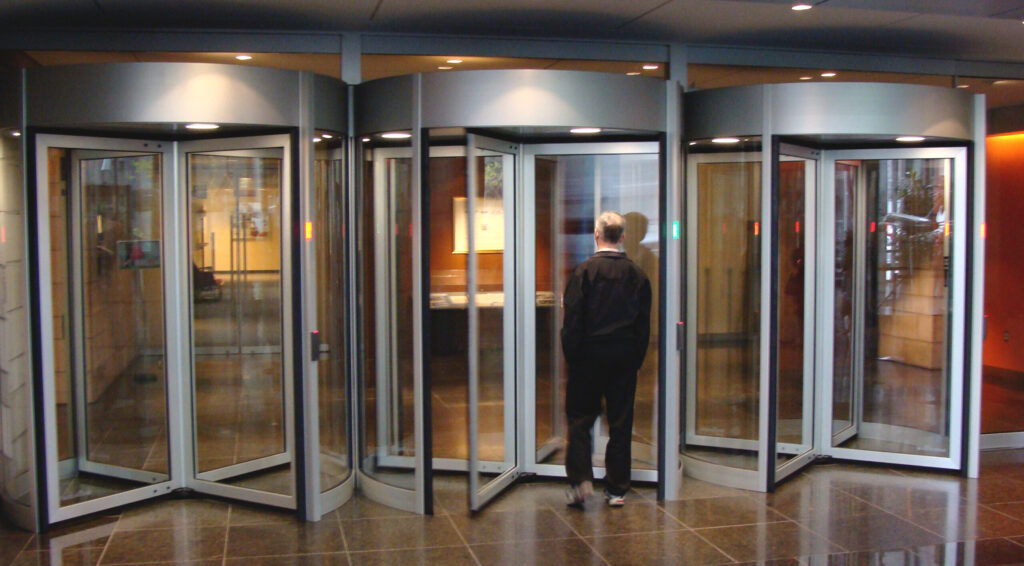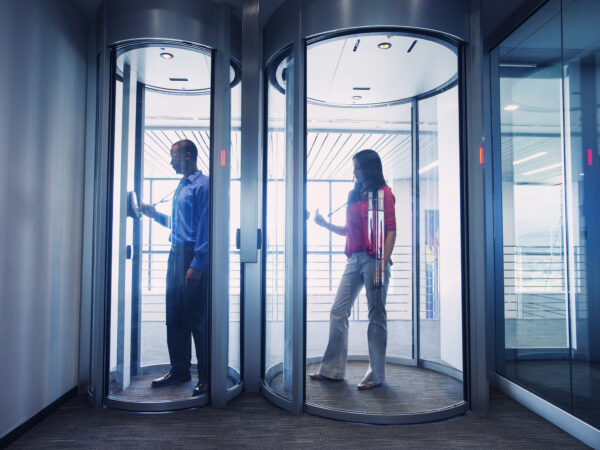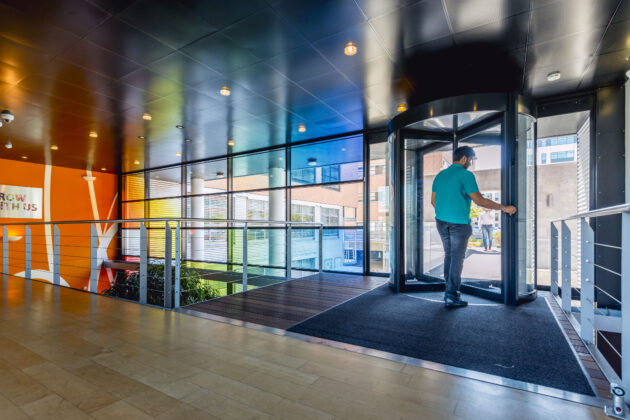
Features
Harden your entrances: Three expert tips
November 13, 2023 By Joseph Seagriff
 Image: Boon Edam
Image: Boon Edam It is becoming more of a challenge than ever before for organizations of all types to maintain a secure environment.
Even when certain secured entry solutions are already in place, there can still be a variety of different risks and threats to the staff, visitors, and others on the premises. For many, ripping and replacing with new construction is financially out of reach, but fortunately there are a number of choices you can make to improve your risk-mitigation strategy.
Here are three expert tips on upgrading your existing entrances.
1. Make your glass vandal-resistant
One way a criminal might attempt to enter a building when access is denied is by trying to smash the glass of an entrance door. Criminals may see this as a fast and easy way to get into a building in order to commit a crime. This mode of entry is typically carried out by someone unconcerned with stealth, and also by someone who is more likely to be violent once they have entered the premises.
Some of these cases are pure vandalism, with criminals throwing rocks or other projectiles at glass doors simply to cause as much mayhem and damage as possible to make a political statement or just for “fun.” Others are even more dangerous, with active shooters and other violent criminals entering buildings to cause extreme harm. Perhaps one of the most significant risks which has risen over the past decade has been workplace violence.
While many instances of workplace violence are personally targeted at specific individuals, the overall threat level is exacerbated by a disturbing environment of rising social misconduct around the world. This is only expected to increase with current global tensions and growing divisions, many of which take the form of public demonstrations that too often threaten public facing businesses and organizations.
The rise of criminal thefts and vandalism is also of growing concern. The retail industry continues to be victimized by “smash-and-grab” burglaries, wherein a group of individuals smashes open the doors to retail establishments and hauls out as much merchandise as they can, as quickly as they can. This same technique is also being used to enter office buildings, including financial, technology, health care, or government operations, among others.
To strengthen security against these types of crimes, it is essential to strengthen the door itself. While some building owners or managers might think that it would be necessary to install heavy steel or other industrial-looking doors to achieve this level of security, it is not required. Not only would doors of this type detract from the appearance and prestige of a building, there is also a much better option. Using vandal-resistant glass for security entrances and architectural revolving doors provides an added layer of protection while maintaining the architectural character of the entry.
Smash-resistant laminate film is another effective option to fortify existing glass-equipped security entrances. This type of glass solution is meticulously engineered and designed to withstand a range of impact forces, from blunt objects to sharp tools. When applied, the laminate film causes glass to crack like a spider web when hit, instead of shattering into multiple pieces. Because the treated glass cannot be easily broken, the extra time and effort required to break through it provides a significant deterrent to assailants looking for fast and easy targets.
In addition to smash-resistant film, security and loss prevention teams can further fortify their facilities by leveraging secured entry solutions with additional door reinforcement and protection features. Options such as reinforced frames, high-security locks and additional reinforcements provide layers of defence against unauthorized entry attempts and forced intrusions. By integrating these advanced security measures into their entrance systems, organizations can elevate security and loss prevention efforts and enhance their overall security posture.

Image: Boon Edam
2. Replace swinging doors with security entrances
While access control is a valuable security measure, there is a significant deficiency when the system is deployed with traditional swinging doors. Any entry point that can be compromised by tailgaters entering behind a credentialed person, even when it is a case of authorized employees forgetting their IDs and following behind a colleague, it is a major security liability.
While some access control systems use cameras or sensors to detect tailgating, typically this only means setting off an alarm to notify security staff that someone without authorization has slipped through. Security personnel may not be able to respond in time to stop the perpetrator, who can quickly disappear into the facility to commit theft, vandalism or worse.
By replacing the door with a security revolving door or mantrap portal, neither of which can be held open for a tailgater, you can help to mitigate this risk. Typically, to pass through a security revolving door, someone presents a credential, like an ID badge or passcode, and the door rotates to grant access. To add another layer of security, an entrance that incorporates advanced biometrics such as facial recognition or fingerprint biometrics can be deployed to verify the identity of the individual, and confirm that this identity matches the credentials being presented.
A mantrap portal with biometrics is the most secure choice as it uses a multi-factor authentication process. A mantrap is essentially a vestibule with an exterior door on one side and an interior door on the other. The verification process would involve a user scanning a badge to open the outer door, and then use a face or fingerprint biometric reader to open the second door and enter the building.

Image: Boon Edam
3. Choose turnstiles, revolving doors and mantrap portals with overhead sensors
“Piggybacking” is used to describe a situation in which two people pass together through a turnstile, security revolving door, or mantrap portal using only one authorized credential. It can be an act of collusion, with the two people working together, or it can be forced, with a criminal threatening an individual with violence if they do not comply.
Today it is possible to combat this threat and prevent unauthorized intrusion by choosing security entrances with innovative overhead detection systems that can address piggybacking using Time-of-Flight measurement principles (TOF) to detect whether there are one or two people within the compartment based on shapes and contours. Once a user presents their credentials and the door revolves or opens, the technology scans the compartment, verifying the user is alone. If piggybacking is detected, the turnstile, revolving door, or portal will automatically lock and refuse entry.
Some systems also use near-infrared sensors to detect whether one or more persons have entered a doorway. However, these sensors can still be fooled by a backpack or bulky item that might appear to be a second person, causing a false alarm. The most advanced technology will recognize with certainty whether more than one person has entered the doorway.
Adding a layer of security to your premises does not always require substantial new construction. Simply hardening what you already have can greatly mitigate the risks faced by your organization.
Joseph Seagriff is the vice-president of sales, East Region, Boon Edam (www.boonedam.com).
Print this page
Advertisement
- Frost & Sullivan recognizes Motorola Solutions’ body-worn camera with award
- Axis launches new video solutions at ISC East